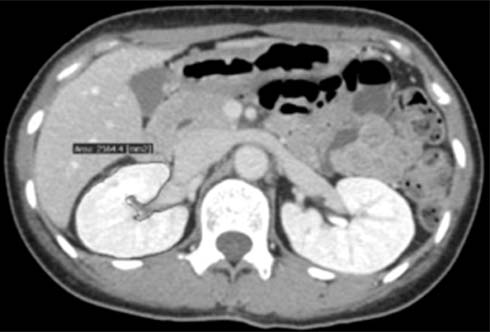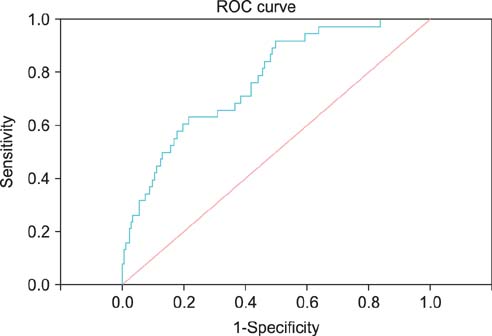Korean J Urol.
2013 Dec;54(12):870-875.
Clinical Implications for Graft Function of a New Equation Model for the Ratio of Living Donor Kidney Volume to Recipient Body Surface Area
- Affiliations
-
- 1Department of Urology, Urological Science Institute, Yonsei University Health System, Seoul, Korea. hanwk@yuhs.ac
- 2Department of Urology, Cheil General Hospital & Women's Healthcare Center, Kwandong University College of Medicine, Seoul, Korea.
- 3Department of Surgery, The Research Institute for Transplantation, Yonsei University Health System, Seoul, Korea.
Abstract
- PURPOSE
We propose an equation that predicts graft function after kidney transplantation by using donated kidney volume and recipient body surface area (BSA).
MATERIALS AND METHODS
Included were 261 cases of living kidney transplantation between 2007 and 2009. Preoperative computed tomography scans were performed and the donated kidney volume was measured by use of a three-dimensional reconstruction program (Ripidia). The estimated glomerular filtration rate (eGFR) was calculated by using the modification of diet in renal disease formula. Donated kidney volume, preoperative renal function, and demographic factors of both donors and recipients were evaluated as predictors.
RESULTS
The mean ages of the donors and recipients were 40.8 and 41.6 years, respectively. The mean donated kidney volume and donated kidney volume/recipient BSA ratio were 153.4 mL and 96.9 mL/m2, respectively. Mean preoperative and postoperative 12-month eGFR of recipients were 7.1 and 59.7 mL/min, respectively, and the mean preoperative eGFR of donors was 92.2 mL/min. Donated kidney volume/recipient BSA ratio, donor age, and recipient gender were the significant predictors of eGFR level (p<0.001) and eGFR<45 mL/min at postoperative 12 months (p=0.005, p<0.001, and p=0.006). From the multiple linear regression equation and predicted probability from logistic regression, we could calculate the equation for the ratio of living donor kidney volume to recipient BSA on graft function.
CONCLUSIONS
Graft kidney volume/recipient BSA ratio, donor age, and recipient gender were predictors of graft function 12 months after kidney transplantation. Although we are concerned only with the preoperative, this equation model could help physicians to counsel patients concerning their postoperative prognosis and to avoid insufficient volume donations.
MeSH Terms
Figure
Reference
-
1. Hugen CM, Polcari AJ, Farooq AV, Fitzgerald MP, Holt DR, Milner JE. Size does matter: donor renal volume predicts recipient function following live donor renal transplantation. J Urol. 2011; 185:605–609.2. Oh CK, Jeon KO, Kim HJ, Kim SI, Kim YS, Pelletier SJ. Metabolic demand and renal mass supply affecting the early graft function after living donor kidney transplantation. Kidney Int. 2005; 67:744–749.3. Lee JH, Won JH, Oh CK. Impact of the ratio of graft kidney volume to recipient body surface area on graft function after live donor kidney transplantation. Clin Transplant. 2011; 25:E647–E655.4. Huh KH, Yun M, Kim TS, Cho A, Lee JD, Myoung SM, et al. Measurement of donor kidney functional renal volume and glomerular filtration rate to predict allograft function during the post-transplantation period. Nephron Clin Pract. 2009; 113:c262–c269.5. Kasiske BL, Snyder JJ, Gilbertson D. Inadequate donor size in cadaver kidney transplantation. J Am Soc Nephrol. 2002; 13:2152–2159.6. Miles AM, Sumrani N, John S, Markell MS, Distant DA, Maursky V, et al. The effect of kidney size on cadaveric renal allograft outcome. Transplantation. 1996; 61:894–897.7. Nicholson ML, Windmill DC, Horsburgh T, Harris KP. Influence of allograft size to recipient body-weight ratio on the long-term outcome of renal transplantation. Br J Surg. 2000; 87:314–319.8. Szabo AJ, Muller V, Chen GF, Samsell LJ, Erdely A, Baylis C. Nephron number determines susceptibility to renal mass reduction-induced CKD in Lewis and Fisher 344 rats: implications for development of experimentally induced chronic allograft nephropathy. Nephrol Dial Transplant. 2008; 23:2492–2495.9. Giral M, Foucher Y, Karam G, Labrune Y, Kessler M, Hurault de Ligny B, et al. Kidney and recipient weight incompatibility reduces long-term graft survival. J Am Soc Nephrol. 2010; 21:1022–1029.10. Douverny JB, Baptista-Silva JC, Pestana JO, Sesso R. Importance of renal mass on graft function outcome after 12 months of living donor kidney transplantation. Nephrol Dial Transplant. 2007; 22:3646–3651.11. Poggio ED, Hila S, Stephany B, Fatica R, Krishnamurthi V, del Bosque C, et al. Donor kidney volume and outcomes following live donor kidney transplantation. Am J Transplant. 2006; 6:616–624.12. Widjaja E, Oxtoby JW, Hale TL, Jones PW, Harden PN, McCall IW. Ultrasound measured renal length versus low dose CT volume in predicting single kidney glomerular filtration rate. Br J Radiol. 2004; 77:759–764.13. Foss A, Line PD, Brabrand K, Midtvedt K, Hartmann A. A prospective study on size and function of paediatric kidneys (<10 years) transplanted to adults. Nephrol Dial Transplant. 2007; 22:1738–1742.14. Sanusi AA, Arogundade FA, Famurewa OC, Akintomide AO, Soyinka FO, Ojo OE, et al. Relationship of ultrasonographically determined kidney volume with measured GFR, calculated creatinine clearance and other parameters in chronic kidney disease (CKD). Nephrol Dial Transplant. 2009; 24:1690–1694.15. Emamian SA, Nielsen MB, Pedersen JF, Ytte L. Kidney dimensions at sonography: correlation with age, sex, and habitus in 665 adult volunteers. AJR Am J Roentgenol. 1993; 160:83–86.16. Summerlin AL, Lockhart ME, Strang AM, Kolettis PN, Fineberg NS, Smith JK. Determination of split renal function by 3D reconstruction of CT angiograms: a comparison with gamma camera renography. AJR Am J Roentgenol. 2008; 191:1552–1558.17. Stoves J, Lindley EJ, Barnfield MC, Burniston MT, Newstead CG. MDRD equation estimates of glomerular filtration rate in potential living kidney donors and renal transplant recipients with impaired graft function. Nephrol Dial Transplant. 2002; 17:2036–2037.18. Nyengaard JR, Bendtsen TF. Glomerular number and size in relation to age, kidney weight, and body surface in normal man. Anat Rec. 1992; 232:194–201.19. Chen CH, Shu KH, Cheng CH, Wu MJ, Yu TM, Chuang YW, et al. Imaging evaluation of kidney using multidetector computerized tomography in living-related renal transplantation. Transplant Proc. 2012; 44:7–10.20. Sikora MB, Shaaban A, Beddhu S, Bourija H, Wei G, Baird B, et al. Effect of donor kidney volume on recipient outcome: does the "dose" matter? Transplantation. 2012; 94:1124–1130.21. Jeon HG, Lee SR, Joo DJ, Oh YT, Kim MS, Kim YS, et al. Predictors of kidney volume change and delayed kidney function recovery after donor nephrectomy. J Urol. 2010; 184:1057–1063.
- Full Text Links
- Actions
-
Cited
- CITED
-
- Close
- Share
- Similar articles
-
- Impact of Graft Kidney Volume and Weight on Graft Function in Living Donor Kidney Transplantation
- Effect of Donor's and Recipient's Body Traits on the Early Graft Function after Living Donor Kidney Transplantation
- Analysis on Risk Factors for Development of Delayed Graft Function in Living Donor Renal Transplantation
- Early graft function using predicted donor renal cortical volume with CT image analysis
- Influence of the True Living Donor Kidney-Weight to Recipient Body-Weight Ratio on the Post-Transplant 1 Year Renal Allograft Function



